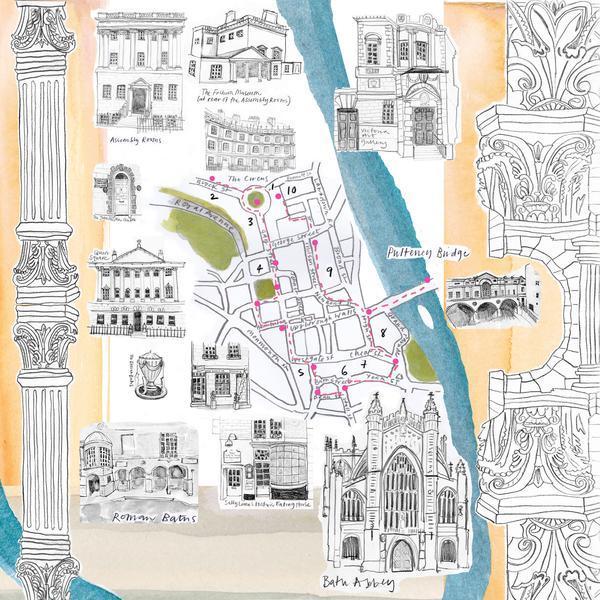
A Walking Tour Of Bath

Clare Lewis, co-author of the Adventure Walks books, has devised a stroll around Bath, perfect to do before or after a trip to the Selvedge Fair in Bath at The Assembly Rooms on Saturday 30th March.
Start your walk at:
1. The Neo-classical Assembly Rooms were the centre of fashionable life in 18th century Bath. Designed by James Wood the Younger in 1769, each of the four rooms – the Great Octagon, Tea Room, Ball Room and Card Room – had a specific purpose. The entertainments, dancing, card playing and recitals carried on beneath glittering Whitefriars crystal chandeliers and were overseen by Master of Ceremonies, Richard “Beau” Nash.
1. The Neo-classical Assembly Rooms were the centre of fashionable life in 18th century Bath. Designed by James Wood the Younger in 1769, each of the four rooms – the Great Octagon, Tea Room, Ball Room and Card Room – had a specific purpose. The entertainments, dancing, card playing and recitals carried on beneath glittering Whitefriars crystal chandeliers and were overseen by Master of Ceremonies, Richard “Beau” Nash.
2. Turn left onto Bennett Street and right at The Circus and right into Brock Street to visit No 1 Royal Crescent, a restored Georgian house turned museum. Walk round the corner to admire the full splendour of the crescent. Although a terrace of individual dwellings it has a single façade, giving the appearance of a grand country house.
3. Head back down Brock Street and right into The Circus, also designed by John Wood the Elder. It is divided into three segments, each facing one of the three entrances, to ensure whichever way you enter there is a classical façade ahead.
4. Walk down Gay Street, looking out for no 25 where Jane Austen once lived. Cross Queen Square with its formal gardens and central obelisk to get the best view of John Wood the Elder’s first speculative development. Then, exit via Princes Street

5. Turn left at Beauford Square, right into Barton Street, right into Westgate Street, and walk along West Gate Buildings to Hot Bath Street and the Thermae Bath Spa, Britain’s only natural thermal spa. Walk along Beau Street, left into Stall Street and right onto York Street. Take the first right under the archway to the One Two Five Gallery, to see Carole Waller’s strikingly original painted textiles.
6. Turn right out of the gallery and right again along North Parade to Sally Lunn’s Historic Eating House for a Bath Bun. This brioche style bun made of milk-based yeast dough sprinkled with crushed sugar became fashionable at the 1851 Great Exhibition. Continue on Terrace Walk. To visit the American Museum, head to the pickup point for the free shuttle bus (see map). Otherwise, turn left down York Street to Bath Abbey, once the heart of the medieval city, with its spectacular George Gilbert Scott fan-vaulted ceiling.
7. Visit the Roman Baths which, having fallen into disrepair after the 5th century, have seen several modifications. The underground spring, Roman baths and temple are now housed in 18th-century buildings designed by John Wood the Elder and John Wood the Younger.

8. Exit on Abbey Churchyard and head to Cheap Street then left onto High Street. Walk past the Guildhall to Bridge Street to visit the Victoria Art Gallery and its fine collection dating from the 15th century to the present day. Head over to the Robert Adam’s Palladian style Pulteney Bridge crossing the Avon, unusual for having its shops spanning both sides.
9. Retrace your steps and turn right onto Northgate Street, left on New Bond Street to Milsom Street. Flanked with grand townhouses this was a fashionable thoroughfare lined with shops in the 18th century.
10. Turn right and then left into Bartlett Street and along St Andrew’s Terrace, back to the Assembly Rooms to visit the Fashion Museum.

1 comment
Reading about all the wonderful and interesting textile-related events you find and/or create, makes me want to live in England!! Or at least visit more often (from California, USA).